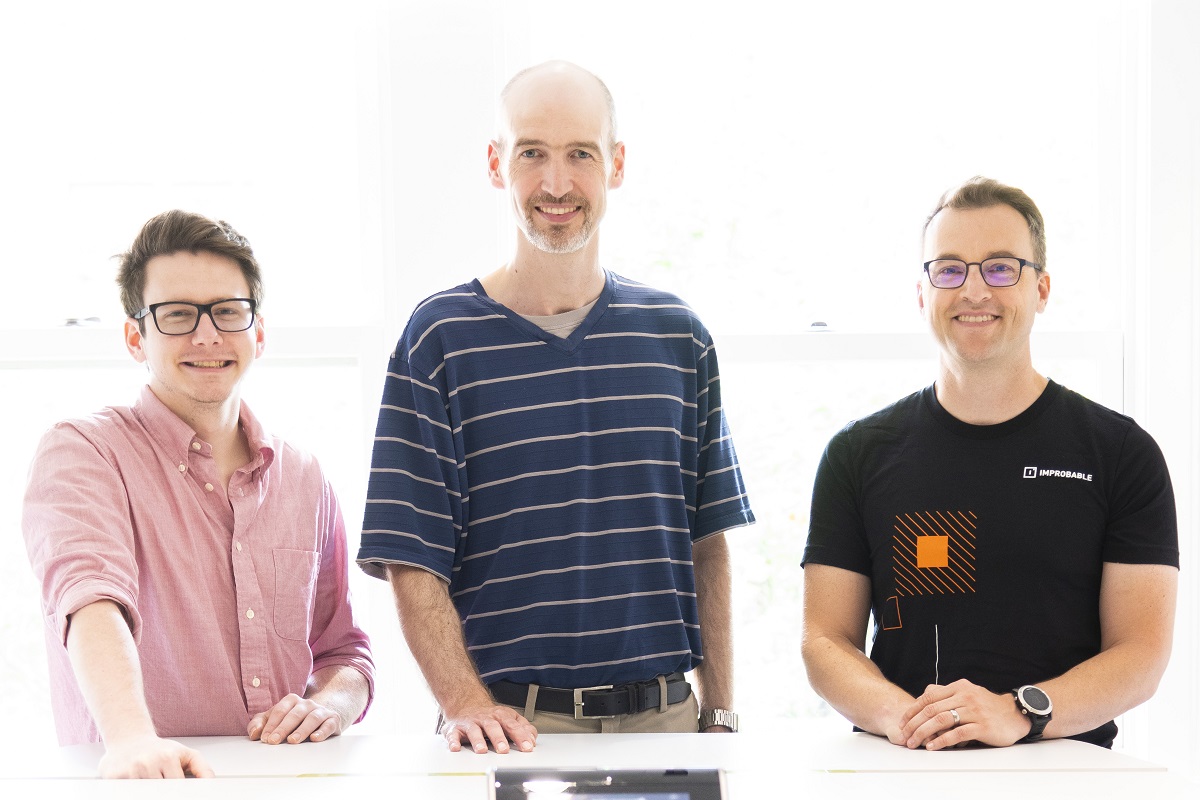
A thriving tech ecosystem in Edmonton is being built by partnerships between UAlberta researchers such as Nathan Sturtevant (centre), tech leaders like Aaryn Flynn of Improbable (right), and recent graduates-turned-employees like Devon Sigurdson (left). Photo by John Ulan.
How does a robot navigate around a room? How does it plan its movement to avoid furniture or falling down the stairs? If it moves outside, is it faster to go around a hill, or to climb over it?
These questions are the basis of pathfinding technology, and the techniques are applicable to more than just robots in the real world-it's also of critical importance in video games. That's why computing scientists at the University of Alberta are engaging in a new research partnership with the Edmonton office of international games company Improbable.
"Research on pathfinding has broad applications, including helping vehicles or robots to navigate on their own," says Nathan Sturtevant (computing science), who is heading up the collaboration with Improbable. "In video games, it's the foundation for how characters move around the game world. As we improve this technology, the way those characters move becomes more efficient, more realistic, and more believable."
Sturtevant runs the MovingAI lab on campus, where their artificial intelligence research is improving how programs determine how to move around three-dimensional space.
"There are many types of research. Some of our work is on more fundamental algorithms and is more abstract-with less obvious applications. But, as in cases like this, it's always exciting to adapt our work so that millions of people can directly experience and benefit from the improvements we make," says Sturtevant.
Path forward
Improbable opened its Edmonton studio in 2018. But the company isn't just focused on building games. Rather, its work centres on creating a new engine called SpatialOS. As general manager (North America) of Improbable and UAlberta computing science alumnus Aaryn Flynn ('96 BSc, '00 BSc) explains, it's a set of tools that other developers will then be able to use to create their own games-and the Edmonton office is using it to develop a game to share its potential.
"Deciding to do this in Edmonton really draws on the strengths of the talent here." -Aaryn Flynn
"Here in Edmonton, we're building a yet-unannounced flagship game to demonstrate the power of SpatialOS in a meaningful way. Deciding to do this in Edmonton really draws on the strengths of the talent here," says Flynn. "That goes for both people we can hire in the community as well as those in the talent network that we can collaborate with-and that's where the impressive research at UAlberta comes in."
Breaking new ground
Sturtevant has already had applications for his research in the games industry, having collaborated with Edmonton video game developer BioWare to create the pathfinding used in the popular video game Dragon Age: Origins. Flynn has also worked with UAlberta in the past while general manager at BioWare, making the new collaboration an exciting opportunity to again work with his alma mater on technology for video games.
"We've begun our new collaboration by working on pathfinding. We've updated and improved approaches to pathfinding significantly," says Sturtevant. "This new work provides more flexibility at runtime and will support interesting character behaviors that weren't possible before."
Sturtevant sees opportunities for research collaboration with industry as one of many ways UAlberta research benefits the local community and industry. Providing a world-class education to students and building local talent is another.
From students to employees
The skills that students develop in their coursework and in leadership opportunities on campus make them well-suited for Edmonton's growing tech and games industries. Devon Sigurdson ('16 BSc, '18 MSc) is one such graduate, now working at Improbable.
"I originally met Aaryn when he visited the lab I worked in during grad school. Aaryn has always shown great interest in AI, and after seeing what we were working on he asked me what my plans were after graduation," says Sigurdson. "After learning that Improbable was growing a team in Edmonton, I applied to join him there as a software developer. Now I work with a team developing our AI and animation systems."
Sigurdson's experience is just one example of how the connection between campus and the local video game industry doesn't end at research partnerships. And as Sturtevant-himself a recent addition to the research and teaching line up on campus-reflects, UAlberta provides a critical component of the Edmonton tech ecosystem: training and seeding the pipeline of skilled people who work in it.
"There are a lot of interesting problems that industry can face that might not occur to us in the lab-working with industry helps us focus on problems that are both challenging and relevant. And in turn, UAlberta's video games certificate program has been very helpful to the local games industry," says Sturtevant.
"The education our students receive here at UAlberta gives them experience in multi-disciplinary teams and develops their skills-so they have the tools for success no matter where their path leads them."